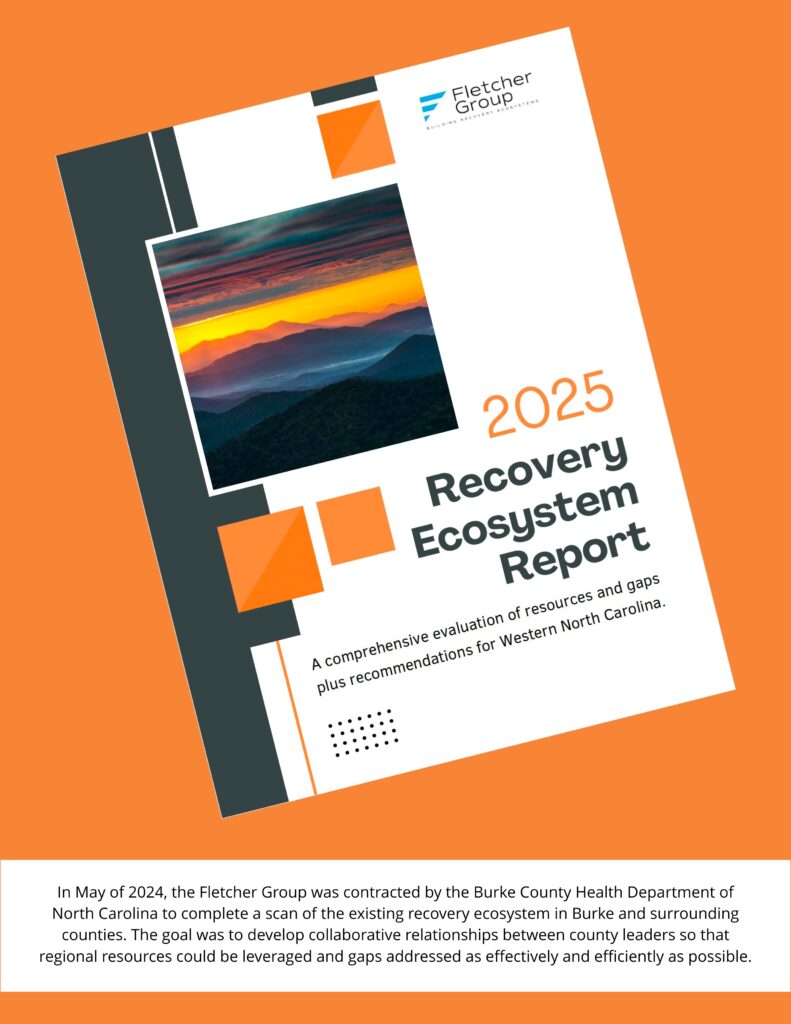Knowledge Is Power!
Fletcher Group Environmental Scans systematically gather and analyze information about your organization’s external environment to inform strategic planning and decision-making. Such evaluations are particularly helpful in identifying potential opportunities, barriers, and threats so that you have a complete understanding of the goals and strategies needed to develop new programs and enhance existing programs.
An excellent example is the 212-page “Recovery Ecosystem Report for Western North Carolina” we completed in 2025 to help the Burke County Health Department and 11 surrounding North Carolina counties address Substance Use Disorder prevention, treatment, and recovery programs by enhancing the region’s recovery ecosystem. (Scroll further down this page to read the report and what went into it.)
What Goes Into a Fletcher Group Recovery Ecosystem Report?
Our recovery ecosystem evaluations assess in detail all the key resources and economic factors in the community such as safe and affordable housing, transportation, access to clinical treatment and healthcare services, social and peer supports, and the education and training people need to gain meaningful employment,
To get an understanding of available SUD treatment services we note and evaluate such things as short-term medically-supervised withdrawal services, inpatient and residential treatment services, outpatient treatment services, and the number of Medication for Addiction Treatment (MAT) providers, counselors, and mental health service providers available in the region.
Additional factors directly impacting your local recovery ecosystem include the number of existing recovery residences, the number of peer-support groups and AA or NA mutual aid groups, the presence of any Recovery Community Organizations (RCOs) as well as recovery coaches and peer mentors. We address prevention, risk reduction, and early intervention programs including syringe service programs, drug courts, re-entry services, Post-Overdose Response Teams (PORT), and Law Enforcement Assisted Diversion (LEAD) programs as well as drug courts and other evolving community programs.
We also take a close look at your surrounding infrastructure and social factors such as transportation accessibility, non-SUD-related affordable/attainable housing, employment and vocational opportunities, educational opportunities including GED and adult education, post-secondary educational opportunities, vocational education, community support networks and social associations, integrated case management services, information-sharing platforms, community education and outreach initiatives, and access to food assistance, legal aid, and child care.
Of course, all of these factors are also impacted by your policy and legal environment. That’s why we also take a close look at state and local policies that support recovery as well as legal deflection and diversion programs, employer policies, fair-chance employment initiatives and opportunities, and anti-discrimination laws.
Data Gathering
We collect information in myriad ways, through listening sessions, interviews, and surveys such as the crucially important Community Needs Assessment Survey. Other important tools include the Formative County Online Assessment, CDC Wonder Data, and the ground-breaking Fletcher Group Economic Calculator developed by our research team to help program operators make wise financial decisions and win the support of stakeholders, funders, community members, and government officials. And of course we can’t forget the Recovery Ecosystem Index Mapping Tool we developed in partnership with researchers at East Tennessee State University and NORC at the University of Chicago. With a simple click on a map, the nation’s first interactive data visualization tool gives users a detailed snapshot of the recovery ecosystem resources available in every U.S. county.
Interpretation and Recommendations
Once it’s collected, we then help you interpret and synthesize the collected data to identify patterns, trends, and potential implications for your organization. The strategic planning that ensues can help you develop a clear understanding of your current situation and future opportunities, including:
- Risk Management so that potential threats can be identified and mitigation plans put into place in advance.
- Opportunity Identification so you’re never caught off-guard by emerging trends and unmet needs.
- Performance Improvement so you can accurately pinpoint areas of improvement and develop a strategic understanding of how to enhance your operations and achieve your goals.
Get In Touch Now!
If a detailed program evaluation sounds helpful to your organization, click here. We’ll be happy to address any questions you may have, so don’t hesitate to reach out.
Care to Read the Report?
To turn the pages of the report below, simply hover your mouse over the lower left corner of each page.
